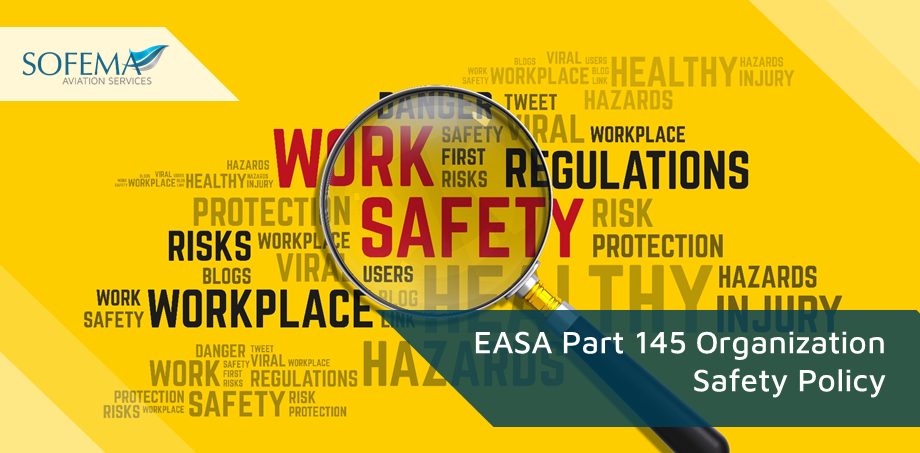Sofema Online (SOL) www.sofemaonline.com – considers the development of a suitable safety policy within an EASA Part 145 Organization.
1.2 Safety Policy and Objectives.
145.A.30(a)2, 145.A.200(a)(2), AMC1 145.A.200(a)(2), 145.A.70(a)2
Safety Policy
To prevent aviation accidents and incidents our organization will maintain an active Safety Management System. Safety is a corporate value of HAS, and we believe in providing our employees and customers with a safe environment.
Safety is one of our core business functions. We are committed to developing, implementing, maintaining, and constantly improving strategies and processes to ensure that all our aviation activities take place under the appropriate allocation of organizational resources (human and financial), aimed at achieving the highest level of safety performance and meeting regulatory requirements, and wherever possible, exceeding requirements while delivering our services.
Our overall safety objective is the proactive management of identifiable hazards and their associated risks with the intent to eliminate their potential for affecting aviation safety and for injury to people and damage to equipment or the environment. To that end, we will continuously examine our operation for these hazards and find ways to minimize their consequences. We train staff on safety management, document our corrective and mitigation actions, and strive for continuous improvement.
Our commitment is also to ensure that sufficient skilled and trained human resources are available to implement safety strategies and processes, all staff are provided with adequate and appropriate aviation safety information and training, are competent in safety matters, and are allocated only tasks commensurate with their skills.
We establish and measure our safety performance against realistic safety performance indicators and safety performance targets, and we have to ensure that externally supplied systems and services to support our operations are delivered meeting our safety performance standards.
I encourage all employees to report significant errors, safety hazards, deficiencies, incidents, or concerns, through the safety reporting system.
I pledge that no staff member will be asked to compromise our safety standards to “get the job done” and that no action will be taken against any employee who discloses a safety concern through the hazard reporting system, unless such disclosure indicates, beyond any reasonable doubt, gross negligence, or a deliberate, or willful disregard of regulations or procedures.
Ultimate accountability for aviation safety in the company rests with me as the Accountable Manager. Responsibility for making our operations safer for everyone, lies with each one of us – from managers to front-line employees. Each manager is responsible for implementing the Safety Management System in his or her area of responsibility and will be held accountable to ensure that all reasonable steps are taken. All employees must comply with this policy.
- To comply with all the applicable legislation, to meet all the applicable requirements, and adopt practices to improve safety standards
- To Provide the necessary resources for the implementation of the safety policy
- To Apply human factors principles, including giving due consideration to the aspects of fatigue
- To Enforce safety as a primary responsibility of all managers
- To always encourage personnel to report maintenance-related errors, incidents and hazards
- To apply ‘just culture’ principles to internal safety reporting and the investigation of occurrences and, in particular, not to make available or use the information on occurrences:
- To attribute blame or liability to front-line personnel or other persons for actions, omissions or decisions taken by them that are commensurate with their experience and training; or
- for any purpose other than the maintenance or improvement of aviation safety
- Within our Organization the commitment to apply ‘just culture’ principles forms the basis for the organization’s internal rules describing how ‘just culture’ principles are guaranteed and implemented
- To Ensure Senior Management continually promote the safety policy to all personnel, demonstrate its commitment to it, and provide necessary human and financial resources for its implementation
- To promote proactive and systematic safety management and positive safety culture
- We define safety objectives, which:
- Form the basis for safety performance monitoring and measurement;
- Reflect the organization’s commitment to maintain or continuously improve the overall effectiveness of the management system;
- Are communicated throughout the organization; and
- Are periodically reviewed to ensure they remain relevant and appropriate for the organization.
- Ensure that safety standards are not reduced by commercial imperatives
- Recognize the need for all personnel to cooperate with the compliance monitoring and internal investigations
Next Steps
Follow this link to our Library to find & Download related documents for Free.
Sofema Aviation Services and Sofema Online provide multiple courses covering Safety Management System activities across multiple domains – please see the websites or contact team@sassofia.com
Tags:
145.A.200(a)(2), 145.A.70(a)2, Accountable Manager, AMC1 145.A.200, AMC1 145.A.200(a)(2), aspects of fatigue, aviation activities, EASA GM2 145.A.30, EASA Part 145 Organization, Ensure Senior Management, front-line employees, HAS, human factors principles, Just Culture, organizational resources, safety performance, safety performance standards, Safety Policy, SAS blogs, Senior Management




